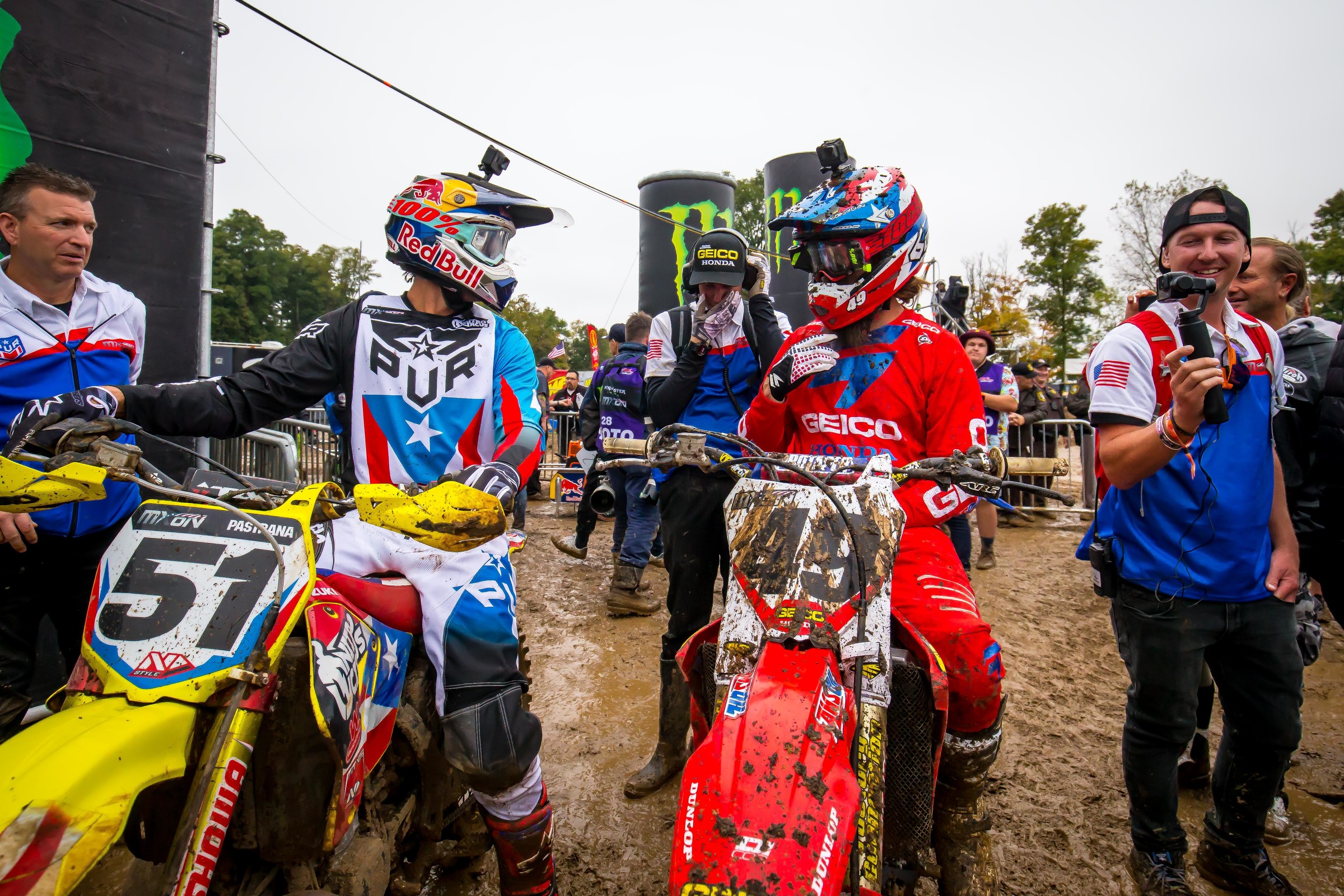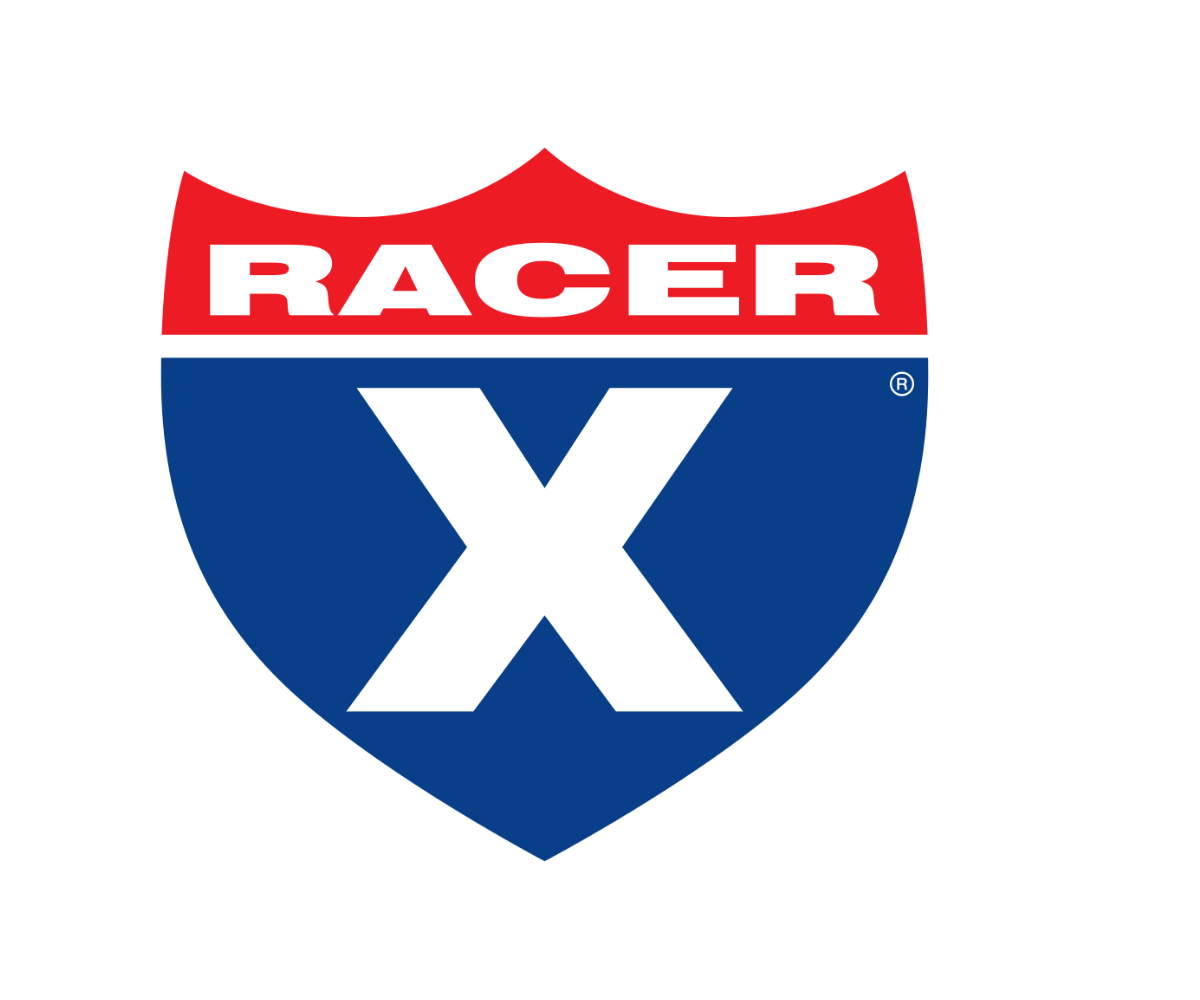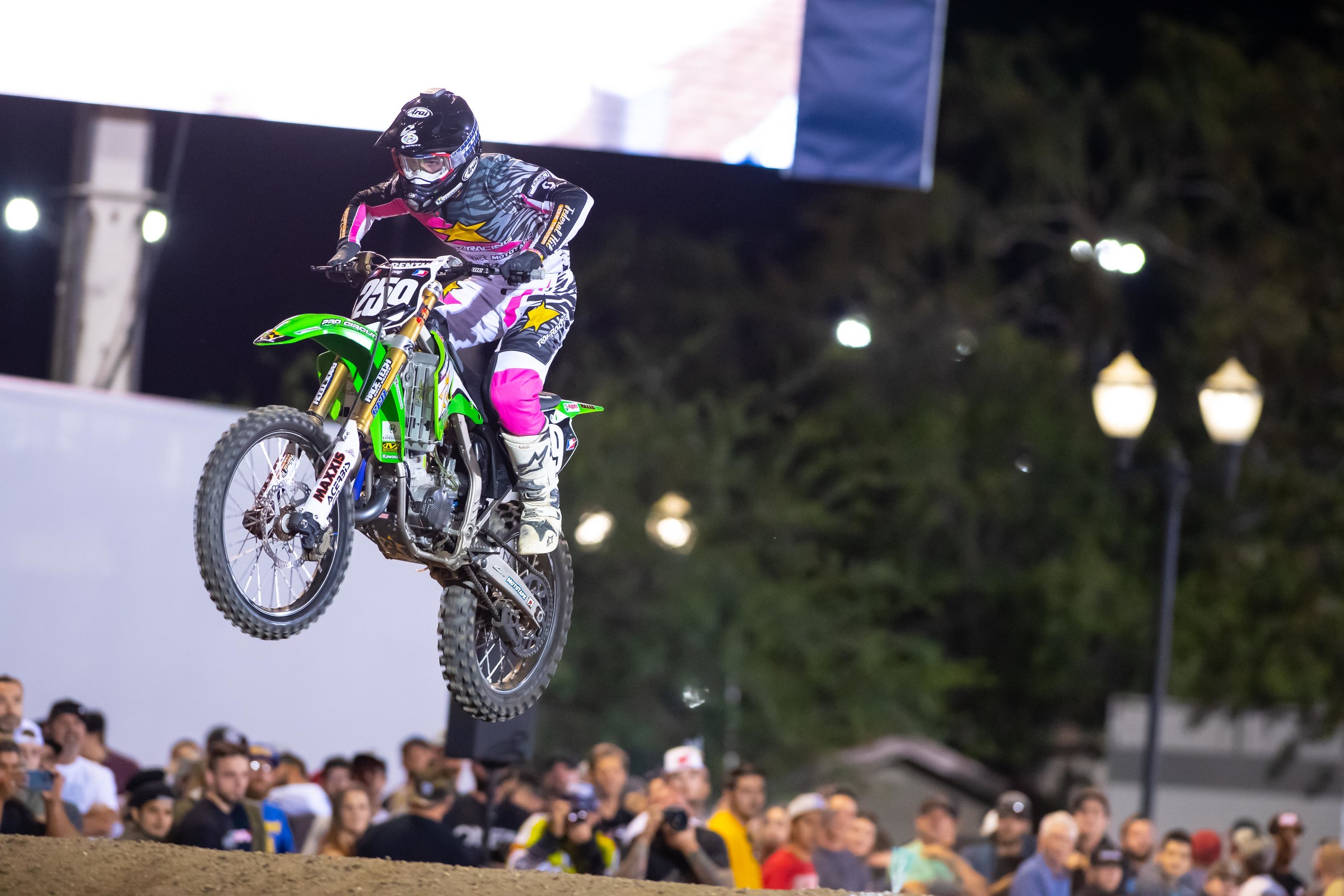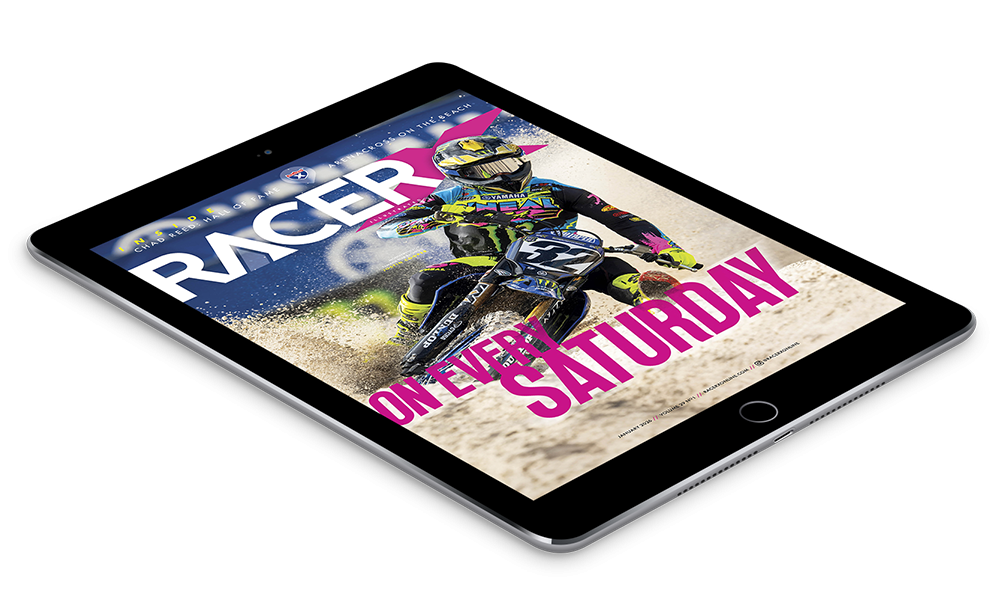It all started a few seasons ago when privateer Michael Leib decided that he was going to run his own gear—all white—due to not having a gear sponsor lined up. Fast forward to 2018 and Canvas MX has been involved in some really cool projects.
Most recently, Canvas has produced one-off gear for Luke Renzland and AJ Cantanzaro for this year’s Red Bull Straight Rhythm—Renzland wore a 1991 Jeremy McGrath Team Peak/Pro Circuit set-up, and Catanzaro donned a gear set that looked identical to James “Bubba” Stewart’s pink zebra stuff from his 125 days—as well as the gear that Travis Pastrana wore at the Motocross of Nations.
The gear that Renzland and Catanzaro wore were so good, that we decided to give the founder of the unique custom gear company a call to learn a little more about the process of making custom gear, working on a few big projects, and what’s next for the brand.
Racer X: You just wrapped up a couple big projects at Red Bull Straight Rhythm with Luke Renzland’s Team Peak gear and AJ Catanzaro’s James Stewart replica gear. Walk us through your involvement in those projects and how that all came to be.
Michael Leib: Yeah, it’s been a pretty crazy summer. Definitely a lot of things have happened since Vegas Supercross. Been kind of focusing my attention to the company. I originally got contacted by Jeremy Malott at Red Bull and he kind of proposed the idea of what was going to take place at Straight Rhythm. AJ Catanzaro was going as James Stewart, and Luke Renzland was going to go as the old McGrath from the Peak Honda days. They kind of presented the idea of trying to do something one-off. Obviously we can make any design. We have the freedom to do whatever is needed, which is really cool. It’s obviously not something that we can sell do to copyright, but to do a one-off event like that, it kind of helps them bring in the character that they were trying to create. It was pretty cool. My partner, Chuck Carothers, and myself and Mitchell Bailey, who did the Luke Renzland design and all that stuff… It’s just been pretty cool to bring something fun to the sport and kind of relive some of the old memories. I think it helped bring a lot of the old memories back of the classic James Stewart. It was cool to watch.
How does that process work? Do you guys just go through old photos and go, “This looks cool?”
You are kind of just looking at stuff and for lack of a better term, we’re just copying other things. AJ Catanzaro had a cool idea to kind of transform some of his current sponsors to make the gold logo look kind of like James Stewart’s Chevy logo on the chest. Obviously the Peak stuff for Luke was a big hit back in the day. That’s an iconic gear set. The same with James’ gear from back then. So, it’s just kind of taking an image of what you want to create and recreating it.
Was there a process of “Here’s this version, let’s tweak it and make it this?” What was the process of getting that gear dialed in?
It always easier when you’ve got something to look at. Obviously there’s been some changes and ways to improve upon the end result of what you’re actually going to go to production with. But the main changes were kind of getting… for example AJ’s current logos of his current sponsors to kind of match the theme of how James’ were placed and giving him a modern spin on it, just utilizing different logos than James’ actually were. There wasn’t a whole lot of back and forth, which was nice. We nailed it pretty quick.
Honestly, with Renzland’s gear, I had to go back and look because I was like, wait, I wonder if they had to get AXO’s permission to use the logo. You guys just had it that close that I swore the logo was on there. So props to you guys for being able to nail it so close without actually using their logos and stuff.
Yeah, we did that on purpose. We don’t ever want to disrespect any other gear company out there. That’s not what we’re here to do, but at the same time it was really cool to piece together some memorabilia that’s just absolutely legendary in our industry and not use their logos, and for that same sake of the argument not to use ours, either. Just to leave the politics out of it and really create the image that we were going after.
Talk a little bit about the feel of gear today versus what that gear would have felt like in 1991.
It’s crazy. 1991, that was actually the year I was born. So, to see gear from then to now, it’s crazy. There was a lot of designs actually back then—I’m sitting here staring at a set of Honda gear from McGrath, Fox stuff. It’s so iconic looking and it’s so cool. I feel like gear has kind of gone through this really weird transition throughout the years of trying to find its place and what looks good and what doesn’t. It’s gone from this cotton, thick, gnarly, heavy stuff to this pajama-feeling gear. It’s gone through a lot of changes. I still think it’s going to continue to go through a lot of changes over the years until we kind of figure out what exactly everyone is liking. You’ve got the old-school guys that like the thicker, more generic-feeling, heavy gear stuff, and then you’ve got the new school guys that are coming up that want the super thin Fox stuff that’s super revolutionary. So figuring out a way to contribute to both worlds is a big plate for a gear company trying to figure out what direction it’s going to go.
Now that you’ve done these old school, kind of throwback projects with AJ and Luke, does that kind of inspire you to maybe do more throwback projects like this for supercross or other races that you know are coming up, for other riders or even for yourself?
Yeah. Having customers write in… Since Straight Rhythm, we’ve had countless emails from people. There was one guy specifically that had a Peak Honda 125, full rebuilt, same year bike. It was to the tee. It just looked so pristine. These guys want this gear. It’s tough because we can’t really sell that because we’re not going to get into copyright infringements and get into the whole legal battle. For one-off projects and stuff, it is cool to do. It’s really cool. Gear companies have never been able to really recreate gear from the past, where people can do a graphics scheme from 1991 and that’s always been an easy thing. We’re the first gear company to actually have the ability to tie the bike and the gear together. So, there is a lot of endless opportunity for us to recreate things with certain people. It’s walking a fine line of just trying to stay out of trouble and not piss other gear companies off that originally made that stuff and keep the respect there for different companies.
If you have a way you want a gear design to look, you don’t have to go buy it. You can just make it, right?
Exactly. The design side of what ways you can take gear, you can go the retro route. You can go the modern route. You can go whatever route you want to go. It kind of leads you into this tunnel of, well, where do I want to go? But I guess that is the cool thing. We can literally make anything someone can create. It’s cool to allow the public the opportunity to go out and if they don’t see something in the regular gear world they like, they can create whatever they want to go after.
You guys got to be a part of was Travis Pastrana’s Team Puerto Rico gear for Motocross of Nations. What that was like to work with a guy like TP and just be involved in that whole Puerto Rico project?
It’s pretty crazy to sit and look back on the things that we’ve done. Our first project as a gear company was Robbie Madison’s wave surf deal that he did. That was my first project. Shortly after that, Chuck Carothers came on and throughout the years we’ve sponsored Taka Higashino, Nate Adams, [we] did Pastrana’s des Nations stuff, did Pastrana’s Hawaii kit that he did his last freestyle world record double backflip 360, I don’t really know what they called that thing. It’s pretty unreal to come from my racing background and to look back and see how much we’ve been a part of in a very short amount of time. My partner, Chuck Carothers, he’s got a great relationship with Travis. We’ve developed a really great relationship with Travis, and as well as with Nitro Circus. To be a part of the Team Puerto Rico deal with Pastrana coming back, what cooler thing has ever come of a des Nations than Kevin Windham, Travis Pastrana, and Ryan Sipes? Kevin Windham and Pastrana were two of my favorite riders of all time, and here I am making gear for Travis Pastrana. It’s just been surreal.
If you could go back ten years ago to the amateur version of yourself and say, “Hey, one day you’re going to make gear for Travis Pastrana,” you would probably think that you were crazy.
Yeah, absolutely. It’s been wild. The design side of Travis’ gear was cool because we got to just go crazy. Regular gear companies, when they make one-off gear and stuff they kind of use stuff that they’ve got to figure out a way to sell or make a decent amount of it before they can actually get away with doing that. We really wanted to just go full-out with the Team Puerto stuff. We actually brought in Alex Staatz at Rival Ink and he did the design work on it. We were just really happy with the way everything with that turned out.
What’s that self-fulfillment like, being a gear company behind all these cool projects you got going on?
I think the cool part for me and the part that I really reflect on are my parents—my mom has a school with On Track. My dad’s owned a countless number of companies in the past, including Rocket Exhaust currently. Just kind of following in their footsteps, being an entrepreneur and figuring out the business world. Racing has always been my priority and will continue to be until that day is no longer. To have a plan B, I guess you could say, which is an amazing plan B, what this company has grown into in a short amount of time, it blows my mind, honestly. It’s pretty amazing to be in the position that we are, and the other projects that we have on the side that we’re getting ready to launch here in the next four or five weeks. I just never would have thought that I would venture down this road and have this much success.
What’s in the future for Canvas? Where you see the company going and what’s next for you guys?
The first thing on our list is we’re going to be 100 percent made in USA here in about five weeks. We were previously—and the company would have never actually started if it wasn’t for Radical Racing—made in Argentina. That’s where our gear was made for the first two years. For the last five months we’ve been making jerseys and our polos and jackets and stuff here domestically. Finding a way to produce a motocross pant here has been probably the biggest challenge. Just lead time, dealing with import duties and shipping costs and everything from getting it from Argentina to here has probably been the biggest challenge. So, first on the list we’ve got an all-new product line coming out, moto pant and jersey, that’s made in USA in about four weeks. To have something that I physically put my hands on, and Chuck Carothers, my partner, had a ton to do with in the sense of finding not only a really good pant to actually manufacture, but a place to make it. To be one of the first “Made in USA” gear companies, that’s something regular gear companies are unable to do, and here I am a 27-year-old kid that races supercross and is kind of figuring out how to do. That part of it is probably my favorite.
Is there a lot of product testing that you guys do behind the scenes? Where do you get the material? Tell me a little bit about the actual physical process of making that.
It took us twelve tries and twelve attempts to actually get to what we just finalized. We finalized this last week. It’s something that I thought was going to take us three. When we got done with our second rendition, I was like, “Alright, we’re pretty close. Almost got this thing in the bag.” Then, nope. We decided to change everything. It’s a lot of testing. You got to put ten to fifteen hours in each pant just to get past the quality testing. Make sure things don’t rip. Make sure that the leather and the material actually goes together. Run it through the washing machine a hundred times, dry it. Beat it up. Do what your regular customers are going to do with it for a few months and figure out where you lie with not only the fit, but the quality of the pant has got to be something that is bar none. We’re making a “Made in USA” pant. It’s got to have the quality and the expectation level that’s going to come behind a USA-made pant. So, it’s endless amounts of work. I never thought that it would be. By the time we got halfway through it, I kind of contemplated if it was worth it or not, but you just have to keep your head down and keep pushing through it. Like I said, my partner, Chuck, has done some pretty amazing things on it to get it to where it is. We’re excited to launch it.
Looking back, the Renzland MC gear, the Catanzaro gear, working with Pastrana on his Puerto Rico gear, what do you hope to see next project-wise for Canvas?
Honestly, when I started Canvas I never saw the company going in the direction that it did. Every month is a new surprise. We’ve got new projects constantly going on. We’ve got a lot of major, major, big, corporate companies contacting us now about doing bulk orders. For those out there reading this, we have bulk pricing if people want to start making and producing your own jersey. That’s a channel that we offer. Those kinds of things, and kind of getting the company to where I’m really happy with it, which we’re just on the brink of being 100 percent made in the USA. There’s a whole other push that I’ve not even really taken on yet, going through the magazines and pushing the company in directions that a lot of people don’t even know about yet. It’s so funny. My dad will talk to all these people and really well-known industry people and they have no idea that I have my own gear company. I like that. It’s kind of funny, because I’ve really not pushed it, and yet we’ve had so much success and opportunity. I like the element of the surprise of where things are going. Obviously I think the next step for us is to sponsor a supercross team and get the gear actually out and visible. It gives teams the opportunity to go and make gear for Target or whoever their title sponsor is. Just change the industry. Originally when I set out for Canvas it was about myself. It was about me finding ways to get sponsors and raise capital on the racing. I believe that this could be a really good vehicle for big teams to be able to utilize that and help bring money back into our sport.
At the end of the day, this company is about uniqueness. I feel like all the projects you had going on and the way the company is going, you’ve really captured that theme and stuck to it.
Yeah. At the end of the day, this company was started, it was an idea for myself to go raise capital on my racing. It’s turned into so much more. The element of the surprise and what’s next is fascinating to me. It’s great to see what we’ve done, where we’ve come from, where we’re headed and how much we’ve accomplished in a short amount of time. It’s been a really fun rollercoaster to be a part of. I think things are kind of just getting started for us.
Thanks for taking the time to chat and talk to us a little bit about what you’ve got going on with Canvas and your projects. Is there anyone else you want to give a shootout to and say thanks to?
Chuck Carothers, my partner. Matt Cordova. Nitro Circus. Travis Pastrana. Everyone that’s been a big part of how we’ve gotten to where we are today. It’s been an awesome ride and I’m excited for what’s next.
For more information on Canvas, visit canvasmx.com.











